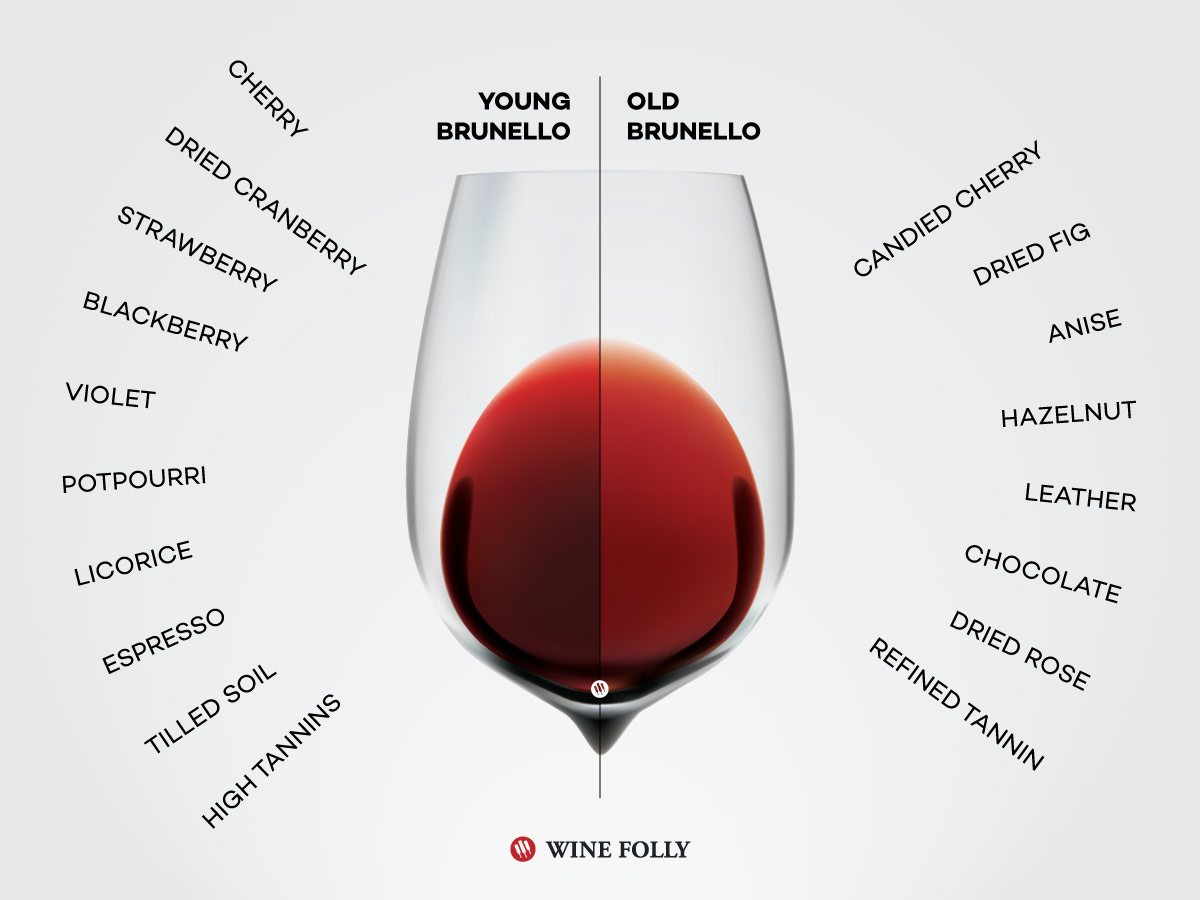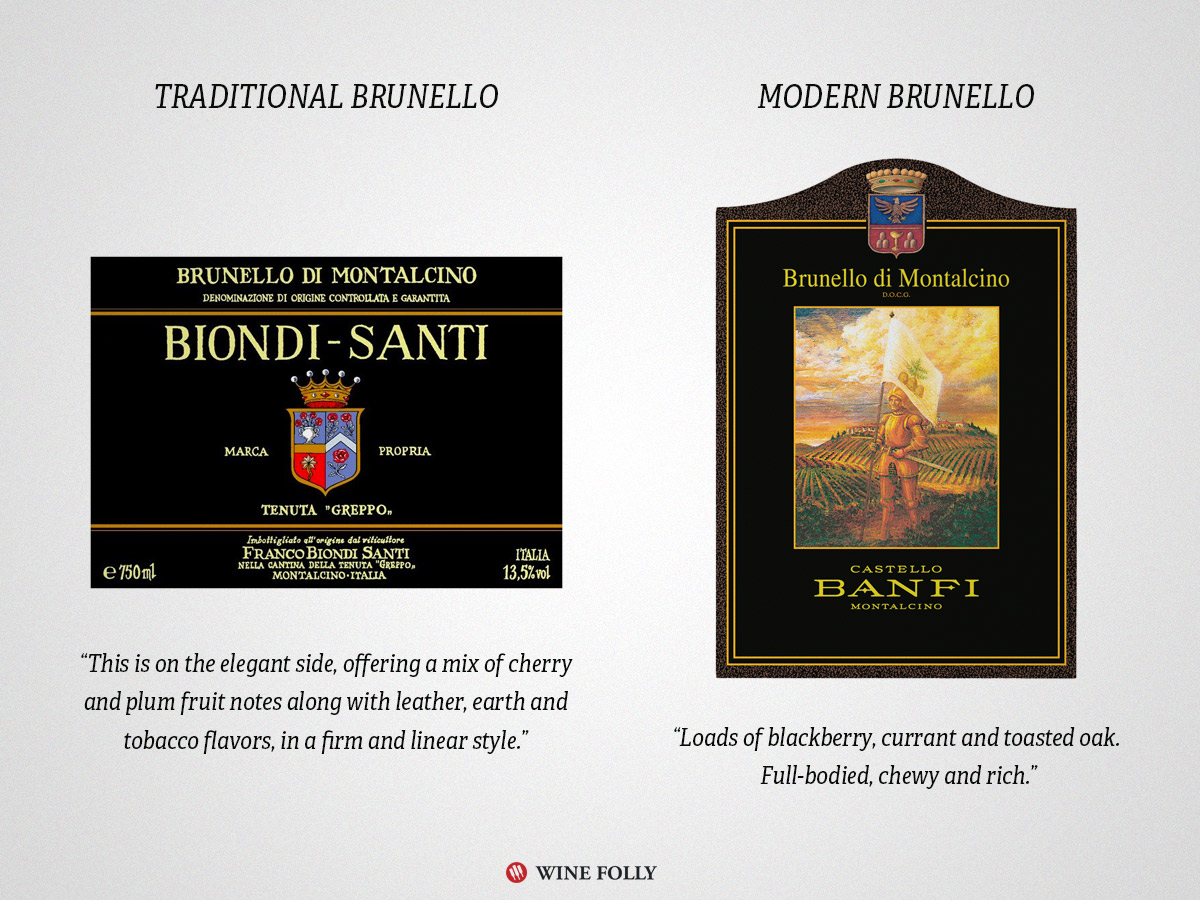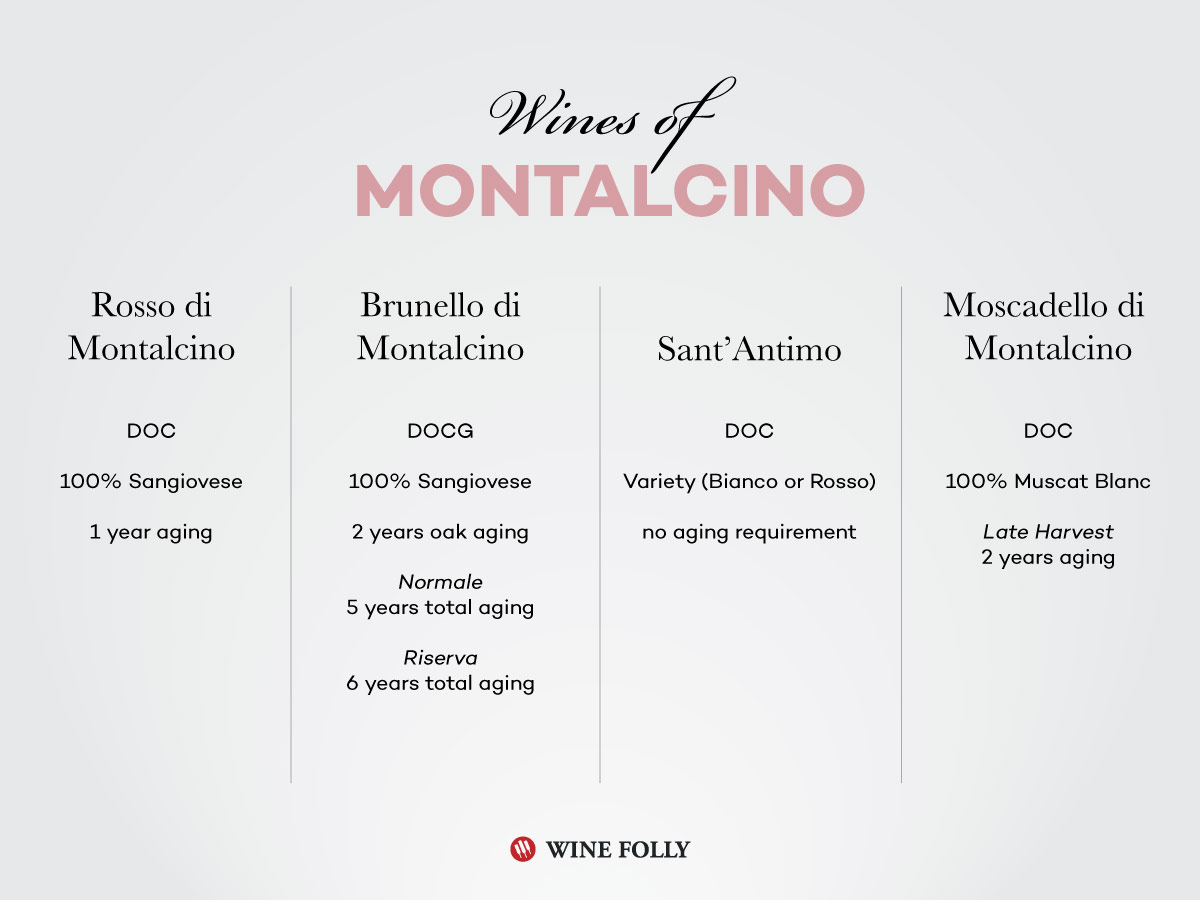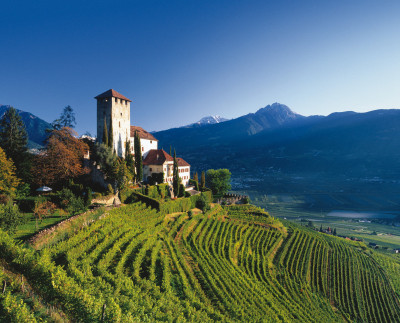Brunello di Montalcino is a wine made with 100% Sangiovese with Italy’s highest DOCG classification. Sangiovese is the wine that most wine critics cite to be the best in all of Italy.
Whether or not it is the best is entirely up to you, but it’s one of those wines to know and perhaps try… at least once in your life.
Brunello… it’s worth the wait.
Brunello di Montalcino is made with a local Tuscan type of Sangiovese referred to as Brunello or Sangiovese Grosso. Some also call it Prugnolo Gentile.
Noted for having thicker-skinned berries, and because of this, Brunello produces wines with exceptionally bold fruit flavors, high tannin, and high acidity.
The fruit is a contributes to the enduring popularity of Brunello di Montalcino. Still, it’s the tannins and acidity that extend the life of this wine, so it reaches perfection a decade or more later. It’s worth the wait.
Tasting Notes
Young Brunello
Imagine a smart – somewhat cocky– exuberant, young brunette. This is a young Brunello.
Wines packed with fruit and flower flavors, including cherries, dried cranberry, wild strawberry, blackberry, violets, potpourri, and licorice. Wow.
When you taste it, Brunello di Montalcino exudes earthy notes of espresso and tilled soil along with mouth-gripping tannins.
It’s a bold wine, but because of the high acidity, it ends on a tart, astringent note that will have you licking the insides of your mouth. This astringency is why most reviews suggest a drink-by window several years after its release date.
Old Brunello
Now that the wine is aged and softened by time, our Brunello is more ravishing than ever.
With 10+ years of age, Brunello di Montalcino drops the fresh fruit flavors to reveal sweeter notes of dried figs, candied cherries, hazelnuts, and sun-baked leather. The tannins turn chocolatey and the acidity is succulent.
I haven’t met anyone drinking perfectly aged Brunello that doesn’t think it’s fantastic.
Vintages
(and a note about vintage variation)
Classic aged Brunello (as mentioned above) doesn’t come along every year. It happens only during a perfect ripening season (not too hot, not too cold). In the last 20 years, we’ve seen about 8 outstanding vintages:
Great Italian Sangiovese Vintages
- 2015 A very well balanced vintage, offering explosive red cherry fruit, balanced tannins, and acidity. This vintage will age for well over 10 years and make sure you age it for at least 8.
- 2012 An outstanding vintage, according to Consorzio Brunello di Montalcino.
- 2010 A fantastic bold fruit vintage offering flavors in both the red and black fruit spectrum with massive tannins. Wines from this vintage should start tasting awesome around 2018–2025
- 2007 An outstanding vintage, according to Consorzio Brunello di Montalcino.
- 2006 Another bold fruit vintage that’s been ready to drink since 2015
- 2004 A great vintage to seek out now
- 2001 Wines from this vintage are heading towards more tertiary fruit development from exceptional producers who focus on more age-worthy wines. Think figs, hazelnuts, stewed cherries.
- 1997 Wines will have more tertiary flavors (nutty flavors, dried fruit, and flower notes) from exceptional producers.
NOTE: You’ll find better pricing on the lesser-loved vintages. Just pay attention to tasting notes where the fruit isn’t too ripe and overblown with licorice/balsamic flavors. Brunello designed for aging should have lots of red fruit flavors and high acidity–the hallmarks of age-worthiness.
Traditional vs. Modern Brunello
Brunello di Montalcino’s wine cannot be released until the 5th year post harvest (6th for “Riserva” bottlings) – some of the longest aging in Italy. In most Brunello wines, you’ll start to notice two schools of thought used for the aging routine with Brunello di Montalcino wines:
Traditional Method: Producers use large, well-used Slavonian oak barrels (called botte from northeastern Croatia) that impart very little oak lactones into the wine and are used simply as vessels to encourage tertiary flavor development through oxygen exposure. Wines develop more dried fruit, leather and flower flavors and have a long aging potential.
Modern Method: Borrowing innovations from France in Bordeaux, some producers use more new, smaller French barrels (called barriques) that impart more oak lactones into the wine and encourage the development of black fruit, chocolate, brown sugar, and vanilla flavors. Because oxygen exposure increases due to oak-to-wine surface area, you can expect modern method Montalcino wines will often be ready to drink sooner than traditional method wines.
Montalcino Wine Facts
There’s more to Montalcino wines than just Brunello. As you’ll see, Rosso di Montalcino offers an outstanding alternative, not only because it uses the same grape, but because the Consorzio has such strict regulations, several would-be Brunello wines are declassified into Rosso level instead.
BRUNELLO DI MONTALCINO 100% Sangiovese (Brunello) produced and bottled in Montalcino. Minimum 12.5% ABV.
- Normale: Released from 1st of January 5 years after harvest with 2 years minimum in oak and 4 months in bottle.
- Riserva: Released from 1st of January 6 years after harvest with 2 years minimum in oak and 6 months in bottle.
ROSSO DI MONTALCINO 100% Sangiovese (Brunello) produced and bottled in Montalcino. Minimum 12% ABV. 1 year aging before release with no oak aging requirements.
SANT’ANTIMO: Any white or red grapes allowed in Tuscany produced as single-varietal wine or blend (labeled Bianco or Rosso) from Montalcino and bottled within Siena. For example, it may include Sangiovese, Cabernet Sauvignon, Merlot, Sauvignon Blanc, Chardonnay, etc.
MOSCADELLO DI MONTALCINO Still, Sparkling and Late Harvest white wines made with 100% Muscat Blanc. Still and Sparkling wines have a minimum of 10.5% ABV and Late Harvest have a minimum of 11.5% ABV (15% potential alcohol). Late Harvest must not be released until 2 years after harvest vintage.
Regional Differences in the Montalcino Area
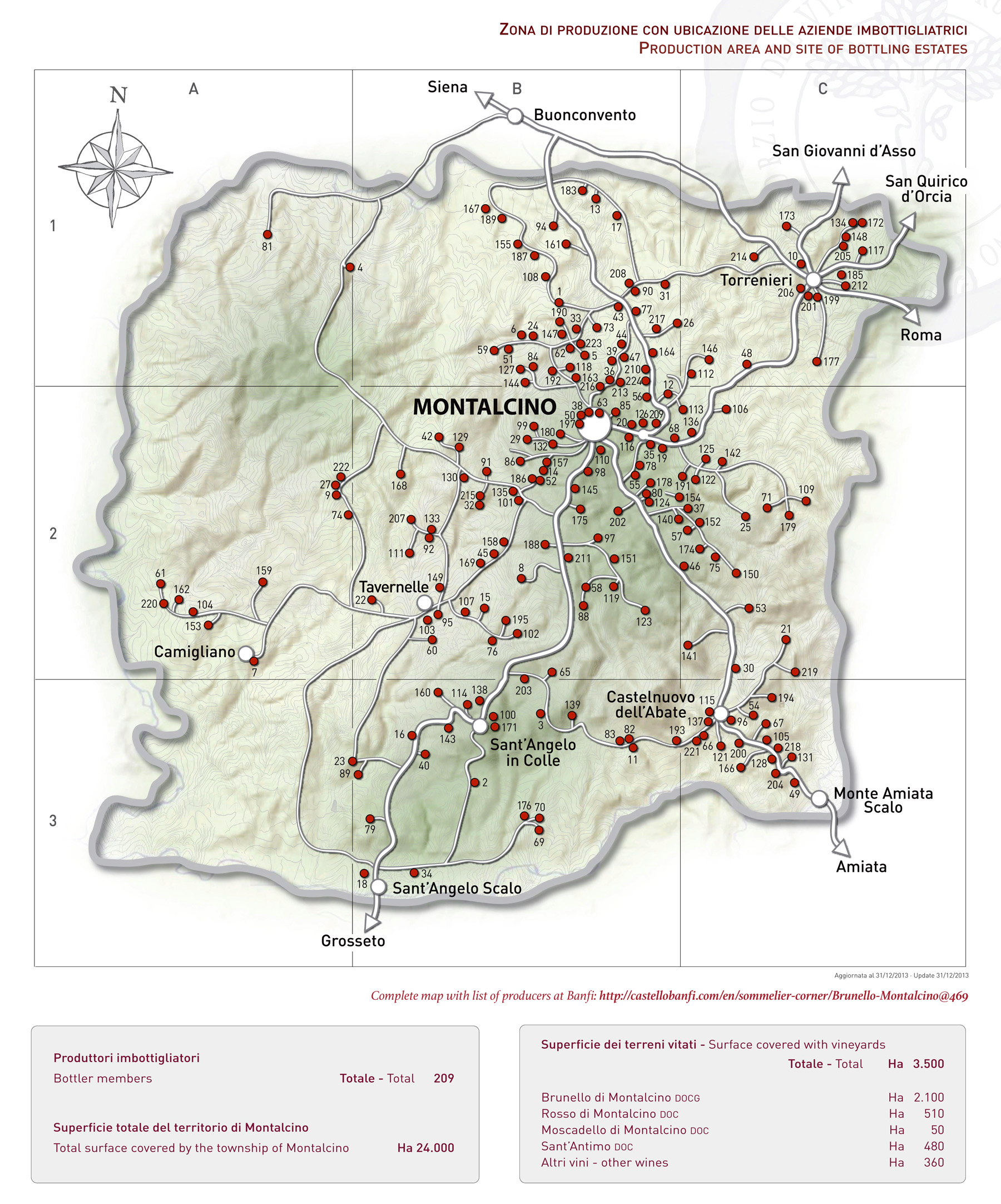
A great deal of the style and quality of Montalcino wines is dependent on the altitude where the grapes grow. Montalcino sits on top of a hilly area, and the vineyards fan out down the hills, and range in elevation from about 1640 ft (500m) to 490 ft (150m). There are some exceptions due to the vineyard site, but generally:
Opulent valleys Towards the base of the Montalcino hills along the river Orcia (Val d’Orcia), there are thicker deposits of clay which produce wines with bolder color, tannin and more intense black fruit flavors. Due to their natural intensity, these wines tend to do well with modern oaking strategies.
Elegant hillside wines The vineyards in the higher elevation areas have much shallower soils of rocky shale (called galestro) and clay and produce lighter-bodied wines with more red fruit and floral aromatics. Due to their natural elegance, wines from these areas do well with more traditional aging regimes.
Last Word
I didn’t get my first taste of Brunello until I had been working in wine for a year. Not for lack of interest. My mouth had watered for the stuff after reading Hugh Johnson’s World Atlas of Wine. I couldn’t afford a bottle. Perhaps this ended up being an advantage: looking back, I didn’t have the right expectations for what to look for and how long Brunello should be aged. Hopefully, this introduction will help you discover your preferred wine. Enjoy the journey!
Explore Italian Wines
See the guide highlighting the top wines of all 20 Italian wine regions.

